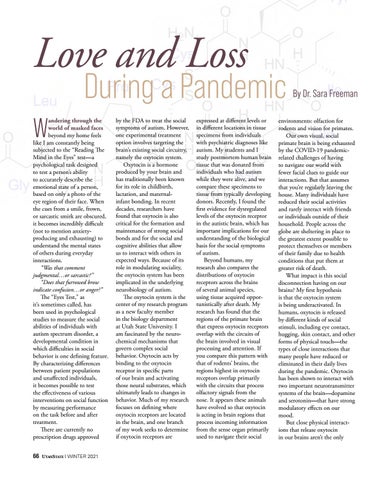Love and Loss
During a Pandemic
W
andering through the world of masked faces beyond my home feels like I am constantly being subjected to the “Reading The Mind in the Eyes” test—a psychological task designed to test a person’s ability to accurately describe the emotional state of a person, based on only a photo of the eye region of their face. When the cues from a smile, frown, or sarcastic smirk are obscured, it becomes incredibly difficult (not to mention anxietyproducing and exhausting) to understand the mental states of others during everyday interactions. “Was that comment judgmental…or sarcastic?” “Does that furrowed brow indicate confusion…or anger?” The “Eyes Test,” as it’s sometimes called, has been used in psychological studies to measure the social abilities of individuals with autism spectrum disorder, a developmental condition in which difficulties in social behavior is one defining feature. By characterizing differences between patient populations and unaffected individuals, it becomes possible to test the effectiveness of various interventions on social function by measuring performance on the task before and after treatment. There are currently no prescription drugs approved
66
UTAHSTATE I WINTER 2021
by the FDA to treat the social symptoms of autism. However, one experimental treatment option involves targeting the brain’s existing social circuitry, namely the oxytocin system. Oxytocin is a hormone produced by your brain and has traditionally been known for its role in childbirth, lactation, and maternalinfant bonding. In recent decades, researchers have found that oxytocin is also critical for the formation and maintenance of strong social bonds and for the social and cognitive abilities that allow us to interact with others in expected ways. Because of its role in modulating sociality, the oxytocin system has been implicated in the underlying neurobiology of autism. The oxytocin system is the center of my research program as a new faculty member in the biology department at Utah State University. I am fascinated by the neurochemical mechanisms that govern complex social behavior. Oxytocin acts by binding to the oxytocin receptor in specific parts of our brain and activating those neural substrates, which ultimately leads to changes in behavior. Much of my research focuses on defining where oxytocin receptors are located in the brain, and one branch of my work seeks to determine if oxytocin receptors are
expressed at different levels or in different locations in tissue specimens from individuals with psychiatric diagnoses like autism. My students and I study postmortem human brain tissue that was donated from individuals who had autism while they were alive, and we compare these specimens to tissue from typically developing donors. Recently, I found the first evidence for dysregulated levels of the oxytocin receptor in the autistic brain, which has important implications for our understanding of the biological basis for the social symptoms of autism. Beyond humans, my research also compares the distributions of oxytocin receptors across the brains of several animal species, using tissue acquired opportunistically after death. My research has found that the regions of the primate brain that express oxytocin receptors overlap with the circuits of the brain involved in visual processing and attention. If you compare this pattern with that of rodents’ brains, the regions highest in oxytocin receptors overlap primarily with the circuits that process olfactory signals from the nose. It appears these animals have evolved so that oxytocin is acting in brain regions that process incoming information from the sense organ primarily used to navigate their social
By Dr. Sara Freeman
environments: olfaction for rodents and vision for primates. Our own visual, social primate brain is being exhausted by the COVID-19 pandemicrelated challenges of having to navigate our world with fewer facial clues to guide our interactions. But that assumes that you’re regularly leaving the house. Many individuals have reduced their social activities and rarely interact with friends or individuals outside of their household. People across the globe are sheltering in place to the greatest extent possible to protect themselves or members of their family due to health conditions that put them at greater risk of death. What impact is this social disconnection having on our brains? My first hypothesis is that the oxytocin system is being underactivated. In humans, oxytocin is released by different kinds of social stimuli, including eye contact, hugging, skin contact, and other forms of physical touch—the types of close interactions that many people have reduced or eliminated in their daily lives during the pandemic. Oxytocin has been shown to interact with two important neurotransmitter systems of the brain—dopamine and serotonin—that have strong modulatory effects on our mood. But close physical interactions that release oxytocin in our brains aren’t the only
